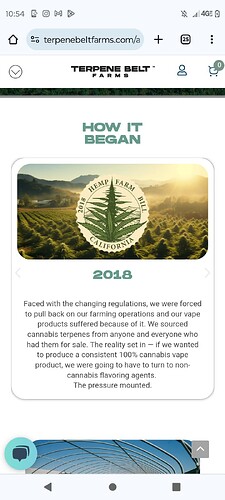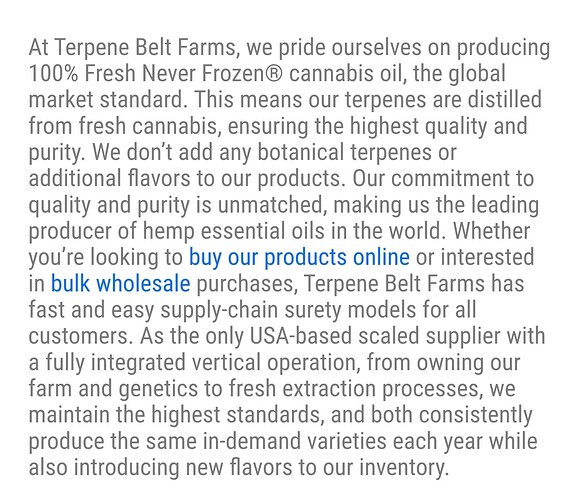Sometimes ur lots are so big and mixed with pehnos/strains, that the only way you can categorize them is by a simple descriptor word and a number.
That would make things a hell of a lot easier than tracking down that initial that was scribbled on painters tape that fell off two transits ago lol
Funny you mention this
I was in marrocco early in the season when folks start buying the femenized seeds for their crops and amazingly it was yust like you mentioned
Ziplock bags with some strain names scribbled 100k seeds per bag at 1€ each sop 100000€ per bag flying of the shelf’s
When asked how do you know if the seeds are any good all I heard was because he say s so
In my younger years I would have bought a bigbag of parrrot feed and sifted the hemp seeds out and sold them for 0.8€ a piece
It s absolute madness
Thanks so much for noticing our naming conventions and menu setup, as well as our commitment to the Fresh Never Frozen extraction process! We’re proud to be the first—and still the only—scaled producer of Cannabis/Hemp-Derived Terpenes. Our entire genetics portfolio was specifically created with terpene diversity in mind, particularly focusing on floral notes, rather than cannabinoids.
Unlike others, our genetics didn’t start with strain names or random seed mixes. Instead, they were developed by a top-notch genetics team, with a clear focus on terpene and flavor variety. To make it easier for manufacturers and brands to know what they’re working with, we categorize the cannabis flavor spectrum into main profiles like Citrus, Pine, Fruit, Sweet, Savory, Purple, Dessert, Gas, and Sour.
We believe in letting our customers name and market these profiles as they see fit. Once our varieties are categorized, customers can explore all the individual genetics within each Flavor Profile. For those who are curious, we also assign a “Similar To” strain name to each variety.
For example, you can check out Pine #1, where we detail what strains it’s similar to, its Phytoprint, tasting notes, and a full breakdown of the terpene content.
And yes—our process is 100% Solventless! A few years back, we built the world’s largest steam extraction plant, specifically for our terpene business. We take freshly harvested flowers straight from the field (variety by variety) and move them to onsite extraction, producing top-quality terpenes within 45 minutes of harvest—no drying, curing, or freezing involved.
If you’re in the market, we’d love to connect! Just fill out our contact form, and we’d be happy to share more about what we do.
What do you consider scaled? I know many outfits running hundreds of acres exclusively for terpenes, and have for many years.
I’d also be surprised if your claims of the “worlds largest steam extraction plants” are true considering there are some pretty massive steam extraction plants for mint and lavender.
Im not validating any of @TerpeneBeltFarms claims or sales pitch’s but i can verify that to date they have the best terps we have ever bought. (we have tried every brand mentioned on this thread) They do cost more then most companies but you get what you pay for. if you have not tried them id recommend at least giving them a shot. Smell, color, and flavor stand out. unfortunately there pricing was to high for upper chadagment so I’m not allowed to order from them ![]()
Nevermind
But like…are they hemp or cannabis terpenes. Homie doesn’t even seem to know…he called them “cannabis/hemp terpenes”
Thank you for your response and for sharing your insights! When we refer to being “scaled,” we’re highlighting our unique position of owning every step of the process—from our genetics and farm to our extraction machinery. This vertical integration allows us to ensure that the product you buy today will maintain the same high quality and consistency a year from now. It’s this level of control and scalability that sets us apart.
Regarding our steam extraction plant, we understand there are large operations for other botanicals like mint and lavender. However, our claim to having the largest steam extraction plant specifically for cannabis is based on the fact that we designed and built our own machinery tailored to the unique needs of cannabis terpenes. This gives us the ability to produce at scale while maintaining the purity and integrity of our terpenes.
If you’re curious to learn more about our processes and what makes us unique, you can check out some details here: From Soil to Oil: An Untold Journey.
We appreciate your engagement and are always happy to have these conversations!
Hey there, thanks for the question!
Our business uses “hemp” and “cannabis” interchangeably because both terms stem from the same species, Cannabis sativa L., which is the origin of both hemp and marijuana. The key distinction between the two comes down to breeding and regulatory classifications. Breeders have developed different strains of Cannabis sativa L., some focusing on fiber and industrial uses, while others prioritize cannabinoid production for recreational or medical use.
Our breeders have taken this same species and focused on optimizing plants for high terpene output, not for THC. By using Cannabis sativa L. plants, we ensure that our products are compliant with federal regulations and can be shipped nationwide. We use the term “hemp” from a regulatory standpoint, but biologically, both hemp and marijuana come from the same Cannabis plant family.
Here are some resources for the name origin: The Seed of Industrial Hemp (Cannabis sativa L.): Nutritional Quality and Potential Functionality for Human Health and Nutrition - PMC
CBD, marijuana and hemp: What is the difference among these cannabis products, and which are legal? | MSUToday | Michigan State University
Then why did you say on your website, verbatim, “we were going to have to turn to non-cannabis flavoring agents”
What is this sentence referring to if hemp is also cannabis in your opinion?
Full quote is:
“The reality set in — if we wanted to produce a consistent 100% cannabis vape product, we were going to have to turn to non-cannabis flavoring agents.
The pressure mounted.”
So the “we were going to have to turn to…” was theoretical, meaning if they didnt create the solution that they provide, they would have had to use botanicals to keep a consistent lineup.
Here it shows where they claim to not use botanicals
Dont @ me
We have processed 150 tons of fresh flower in a day when we needed to beat an incoming rain. That should give you some perspective on the scale we operate at. We are just happy to see cannabis/hemp derived inputs being used instead of non-cannabis/hemp inputs. We are old school medical marijuana folks from the prop 215/sb420 era of California. We had a choice, make our own terps or use botanical inputs in our own house vape brand. We chose to make our own terps over a decade ago and Terpene Belt Farms is the continuation of that practice. We have some interesting announcing coming up soon that will help folks understand how we are able to do what we do and why we are different. Until then, love and light comrades. Keep spreading the spirit of the plant in whichever way you choose.
Well color me surprised, these cannabis terps were almost as good as their CO2 competitors. picked up a 25ml sample of gas #11 mixed at 6%
25ml sample?! Wow im looking at their menu for my next order in a few weeks out of curiosity and im on the fence about trying a 5ml lol
Also it appears that gas strain is out of stock?
Yes, they have great quality even if it’s “hemp.”
Overtime, we will find that there is a place for every extraction method. Further, producers will focus on growing varieties that express themselves best in their region. This concept of terroir can be found in many industries from vinegar to wine to cheese to whiskey. Soil, elevation, prevailing wind, day temps, night temps, etc will influence the type of cannabis grown in the region. So as the industry matures, a steam distiller in the Central Valley (like us) may produce the best fruit varieties and our success with this pairing will compel other producers in the region to follow suit and eventually the practice they utilize in the region is memorialized and protected through regional trade organizations. Thats how we end up with regional products like Balsamic Vinegar of Modena. Maybe Santa Barbara will produce the gassiest OGs and use hydrocarbon to capture the volatiles. Maybe the emerald triangle will grow the best purple and run a Solventless process. In the the product, the producers, and the story they tell will represent the region. I say that, to say this. There will be a place in the extraction pantheon for every method of extraction and the market share that region commands will have as much to do with their marketing as their final product.
hey.
good day
we have very good cannabis derived terpenes from original bank seeds of THC genetic we are producing terpenes from 2018 and we grow the plant for terpenes extraction. we have a web site. wildhillsterpenes.com. any question please let me know
best regards
Think you’ve got a typo in the URL.
Unless Will Shill Terpenes is the business model.

